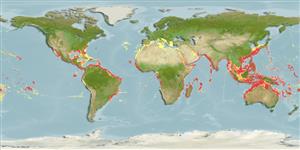Common names from other countries
Lớp phụ Cá sụn (cá mập và cá đuối) (sharks and rays) >
Carcharhiniformes (Ground sharks) >
Carcharhinidae (Requiem sharks)
Etymology: Carcharhinus: karcharos (Gr.), sharp or jagged; rhinus, an ancient name for sharks, from rhine (Gr.), rasp, both words alluding to a shark's jagged, rasp-like skin. (See ETYFish); altimus: Latin for highest, allusion not explained nor evident. (See ETYFish).
Environment: milieu / climate zone / depth range / distribution range
Sinh thái học
Biển Cùng sống ở rạn san hô; Mức độ sâu 12 - 810 m (Ref. 58302), usually 80 - 220 m (Ref. 9253). Subtropical; 46°N - 31°S, 180°W - 180°E
Circumglobal: tropical to temperate watersin the Atlantic, Pacific and Indian oceans. Introduced in the Mediterranean via Gibralltar.
Length at first maturity / Bộ gần gũi / Khối lượng (Trọng lượng) / Age
Maturity: Lm 230.0, range 205 - 282 cm
Max length : 300 cm TL con đực/không giới tính; (Ref. 2334); common length : 250 cm TL con đực/không giới tính; (Ref. 26999); Khối lượng cực đại được công bố: 167.8 kg (Ref. 40637)
Các tia vây lưng cứng (tổng cộng) : 0; Tia cứng vây hậu môn: 0. A heavily-bodied, cylindrical shark with a large, long and broad snout, long nasal flaps and high, triangular, saw-edged upper teeth; interdorsal ridge high and prominent; pectoral and dorsal fins large and straight (Ref. 5578). Grayish with no conspicuous markings, white below (Ref. 5578); inner corners of pectoral fins blackish (Ref. 9997).
Found near the edge of the continental and insular shelves and uppermost slopes (Ref. 244). Rare in shallow waters (Ref. 9997), bottom associated near shelf breaks and drop-offs; young may occur at 25 m (Ref. 58302). Feeds on bony fishes, other sharks, stingrays, and cuttlefish (Ref. 244). Viviparous (Ref. 50449). Utilized for fishmeal, liver oil, and shagreen (Ref. 9997). Minimum depth reported taken from Ref. 244.
Viviparous, placental (Ref. 50449). Gives birth every second year with 1-13 (average 9) pups per litter (Ref. 58048). In the Mediterranean, sharks give birth in August and September, however in Madagascar, young are born in September and October (Ref. 244). Size at birth 60-75 cm (Ref. 6871); 70-90 cm TL (Ref.58048). Distinct pairing with embrace (Ref. 205).
Compagno, L.J.V., 1984. FAO Species Catalogue. Vol. 4. Sharks of the world. An annotated and illustrated catalogue of shark species known to date. Part 2 - Carcharhiniformes. FAO Fish. Synop. 125(4/2):251-655. Rome: FAO. (Ref. 244)
IUCN Red List Status (Ref. 130435)
Human uses
Các nghề cá: buôn bán nhỏ
Các công cụ
Special reports
Download XML
Các nguồn internet
Estimates based on models
Preferred temperature (Ref.
115969): 13.8 - 26.5, mean 19.9 (based on 875 cells).
Phylogenetic diversity index (Ref.
82804): PD
50 = 0.5000 [Uniqueness, from 0.5 = low to 2.0 = high].
Bayesian length-weight: a=0.00331 (0.00178 - 0.00617), b=3.11 (2.96 - 3.26), in cm Total Length, based on LWR estimates for this species & Genus-body shape (Ref.
93245).
Mức dinh dưỡng (Ref.
69278): 4.5 ±0.3 se; based on diet studies.
Thích nghi nhanh (Ref.
120179): Rất thấp, thời gian nhân đôi của chủng quần tối thiểu là hơn 14 năm (Fec=1-13;).
Fishing Vulnerability (Ref.
59153): Very high vulnerability (90 of 100).
